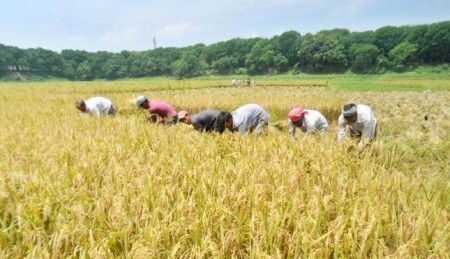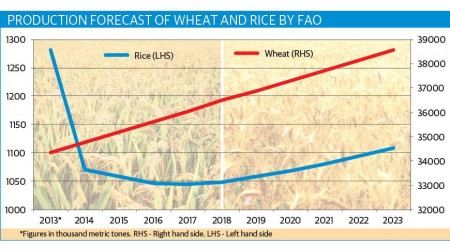Bangladesh may continue to break record in rice crop production in the next 10 years, said Food and Agriculture Organisation (FAO) in its latest forecast.
Production of rice, the main crop of Bangladesh, was estimated at 34.8 million metric tonnes in 2014, up from 34.4 million metric tonnes in the previous year, according to the Agricultural Outlook 2014-2023 released recently.
The FAO of the United Nations and the Organisation for Economic Cooperation and Development (OECD) in the joint report said rice output may reach to 38.6 million metric tonnes by 2023.
The report provides a 10-year forward looking assessment of trends and prospects in the major temperate-zone agricultural commodity markets of cereals, cotton, oilseeds, sugar, meat, fish and dairy products.
It is published annually, in the middle of the second quarter, as part of a continuing effort to promote informed discussion of emerging market and policy issues.
“Domestic rice prices decreased slightly in May with the start of the 2014 Boro season harvest and were higher than a year earlier,” the UN agency said.
It said rice prices are expected to decline further in the coming months when the bulk of the harvest will enter the markets.
Similarly, wheat flour prices weakened in May, as a result of the record 2014 harvest and continuing distributions by the government through open market sales.
However, the ongoing procurement programme, which ended in June, offset further price declines.
According to the central bank of Bangladesh, the year-on-year CPI in April 2014 was recorded at 7.5% relative to the same period last year.
The FAO also expected production of wheat crop might decline to 1.1 million metric tonnes this year, down from 1.3 million metric tonnes in 2013. Total output by 2013 may stand at 1.2 million metric tonnes.
Planting of the 2014 Aus season rice crop was completed by mid-May. According to remote-sensed data, rainfall from early March to early June over the main rice-producing areas has been above-average, facilitating land preparation and early crop development, said FAO.
FAO’s initial forecasts put this season’s rice output at 3.6 million tonnes, 3% above the corresponding season of last year.
Assuming a good monsoon season and continued government support to the rice sector, FAO tentatively forecasts the 2014 aggregate rice production (including the ongoing Aus, Aman and Boro seasons) at 52 million tonnes, similar to last year’s record output.
On average, Aus, Aman and Boro seasons account for 7%, 38% and 55%, respectively of annual paddy production.
Earlier in 2011, the country produced a record 34.25 million tonnes of rice as against the total known demand for about 31 million tonnes to feed its people.
Officials at the Department of Agriculture Extension (DAE) attributed continued favourable weather conditions, use of high yielding variety seeds and government support to increasing food grain production in the country.
“The growth in production was achieved by fast adoption of high-yielding crop varieties supported by rapid expansion of irrigation which helped booming rice production,” said a scientist working in the DAE.
Source: Ittefaq











